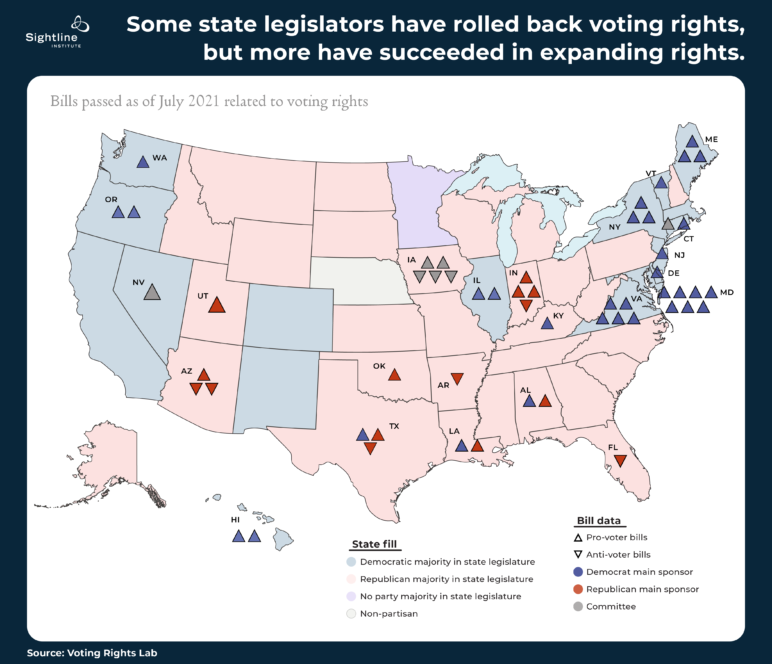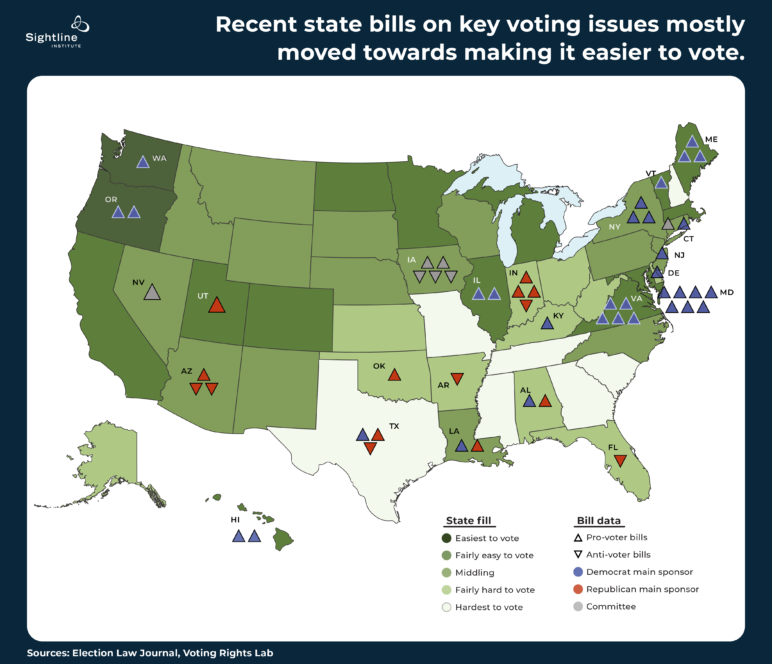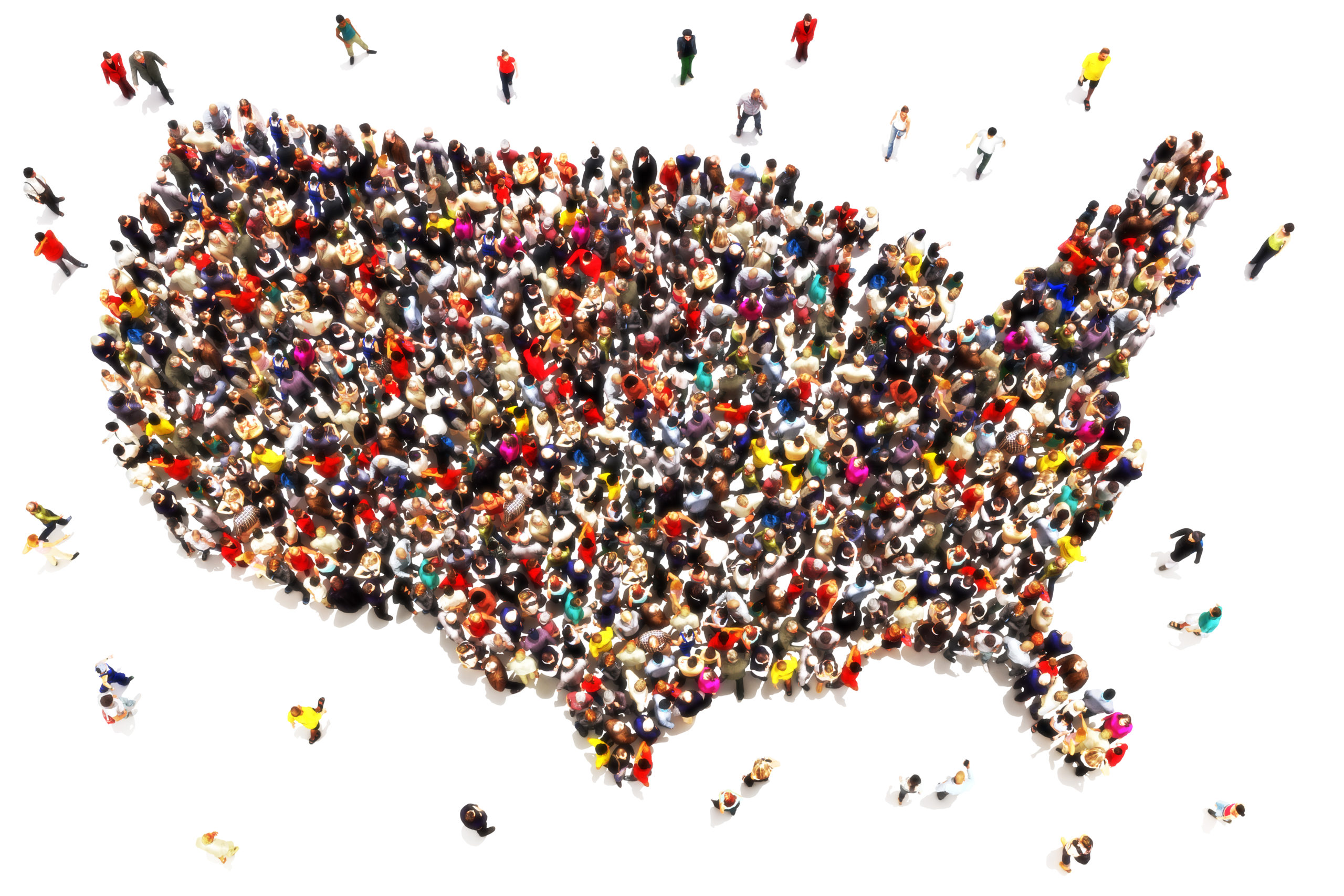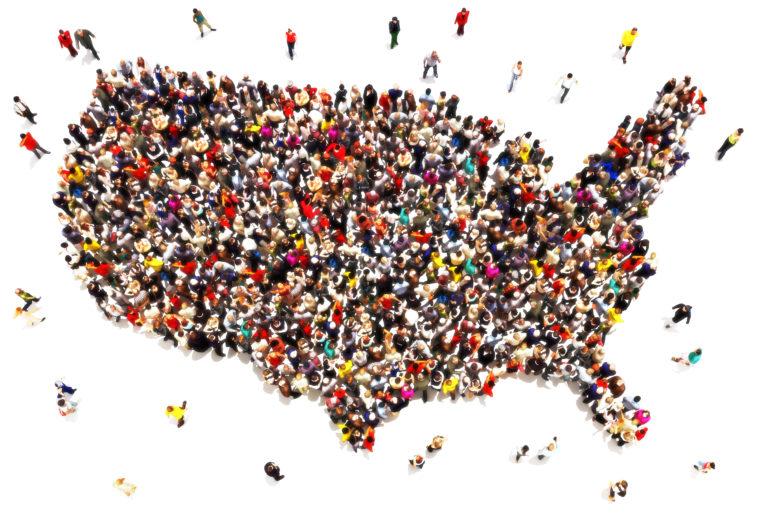Oregon and Washington know how to make it easy and safe to vote. Experts from here have been trying to share our experience with other states so that all Americans can have it as good as voters in this corner of the country have got it. Some state lawmakers are listening. Others are covering their ears and yelling “la la la I can’t hear you” as they move backwards, making it harder for their people to vote.
State lawmakers introduced a tsunami of voting-related bills in 2021. Now that most legislative sessions have ended, which bills actually passed? The Brennan Center for Justice has identified a total of 28 bills that could restrict voting access (some more significantly than others). Sightline has been tracking a narrower set of bills related to 11 key policies that make it easier and more secure for Americans to vote, particularly relating to voting rights and absentee voting. We are not tracking, for example, bills that expand partisan legislators’ power over county election officials, or prohibitions on giving water to voters waiting in long lines, so Georgia’s shenanigans do not show up in our maps below. But on the key policies we are tracking, there is good news! State bills that passed are mostly pro-voter. Only a few states chose to make life harder for voters.
The partisan pattern of these bills is mostly unsurprising: Democrat-sponsored (blue triangles in the maps below) pro-voter bills (upward triangles) in Democrat-controlled legislatures (blue states) passed, while the few anti-voter bills (downward triangles) were all Republican-sponsored (red triangles) in Republican-controlled states (red states). Republican-controlled Iowa had a flurry of committee bills which do not have a party-affiliated sponsor so are gray in the maps below, but they were likely furthering the agenda of the majority party. There were a few exceptions: Republican lawmakers in Arizona, Indiana, Oklahoma, Louisiana, Texas (!) and Utah all chose to make some improvements.
 In addition to the partisan pattern, the state bills show a regional pattern. The map below colors states according to their Cost of Voting Index score, which measures more than 30 factors to score how easy (dark green) or hard (lightest green) it is to vote in each state. Western states lead the pack on ease of voting, while Southern and Appalachian states tend to lag. Democrat-controlled northeastern states like New York, New Jersey, Maryland, Virginia, Vermont, and Maine saw a flurry of laws as they tried to catch up with Oregon and Washington. But Western states aren’t sitting on their laurels—Washington, Oregon, and Utah all passed bills making further improvements.
In addition to the partisan pattern, the state bills show a regional pattern. The map below colors states according to their Cost of Voting Index score, which measures more than 30 factors to score how easy (dark green) or hard (lightest green) it is to vote in each state. Western states lead the pack on ease of voting, while Southern and Appalachian states tend to lag. Democrat-controlled northeastern states like New York, New Jersey, Maryland, Virginia, Vermont, and Maine saw a flurry of laws as they tried to catch up with Oregon and Washington. But Western states aren’t sitting on their laurels—Washington, Oregon, and Utah all passed bills making further improvements.
Meanwhile, in Southern states where it is already relatively harder to vote, like Texas, Florida, and Arkansas, Republican lawmakers mostly tried to make voting even harder. Again, there were exceptions: lawmakers in the not-so-voter-friendly states of Alabama, Indiana, Kentucky, and Oklahoma made some changes to help voters.
 Our earlier article describes each of the 11 policies in greater detail. Here is a summary of the 11 policies we followed, and which states ended up passing bills.
Our earlier article describes each of the 11 policies in greater detail. Here is a summary of the 11 policies we followed, and which states ended up passing bills.
Policies with only pro-voter bills passing
On six of our key 11 policies, sixteen states passed pro-voter bills and zero states passed anti-voter bills. Those popular policies are:
- Restoring voting rights. Connecticut, Maryland, New York, Virginia, and Washington all passed bills automatically restoring voting rights faster to those who have served their time and been released from prison.
- Ballot tracking. Knowing where ballots are in the mail voting process is better for election security and for voter confidence. Lawmakers in Iowa, Kentucky, Maine, Texas, and Utah agree.
- Automatic voter registration. Hawaii, Connecticut, and Delaware created automatic voter registration systems, and Maine, Nevada, and New York improved their systems.
- No-excuse absentee voting. State lawmakers in Connecticut and New York voted to amend the state constitution to create no-excuse absentee voting, removing the previous requirement to provide one of several approved reasons for requesting an absentee ballot. In both cases, the successful bill doesn’t immediately change the law because voters still need to weigh in to change the state constitution. In New York, the people will vote on the amendment this November. In Connecticut, an amendment only goes to the ballot if 75 percent of lawmakers vote for it, or if a majority of two successive legislatures do. The bill fell short of the stringent 75 percent threshold, but if state lawmakers elected in 2023 vote for it will go to the ballot in 2024.
- Pre-paid postage on absentee return envelopes. In three more states, absentee voters won’t have to worry about a stamp getting in the way of their right to vote. Vermont and Virginia will provide postage pre-paid envelopes to all absentee voters, while election officials in Illinois will accept all returned ballots, even if they don’t have sufficient postage.
- Start processing absentee ballots. Alabama, Georgia, Hawaii, Oregon, North Dakota, Maine, Indiana, Kentucky, Virginia, and Florida all passed bills allowing election officials to start processing absentee ballots earlier, thereby speeding up the counting process on Election Night and boosting voter confidence in absentee voting.
Policies with both pro- and anti-voter bills passing
On the other five of our 11 key policies, fifteen states passed pro-voter bills while six passed anti-voter bills. These mixed-result policies are:
- Cure process. This was one of the most successful policies, with many states moving to make it easier for absentee voters who made a mistake to correct that mistake and have their ballot count. Hawaii and Iowa improved their existing cure process, and Kentucky, Maine, North Dakota, Indiana, Virginia, and Vermont all passed bills creating a process by which absentee voters could correct, or “cure,” a mistake such as forgetting to sign their return envelope. Nevada also passed a bill making the process easier to cure a signature mismatch, though the bill also reduced the time allowed for curing mistakes from seven days to six. Only Arizona made it harder for voters, requiring them to fix a missing signature by 7pm on Election Day or have their ballot thrown out. Voters still have five days after an election to fix a mismatched signature.
- Early voting. Indiana, Kentucky, Louisiana, Maryland, New Jersey, Oklahoma, and Virginia all expanded early voting, giving voters more flexibility and reducing wait times on Election Day. Connecticut also passed a resolution proposing to amend the Constitution to allow early voting. As with its attempt to allow no-excuse absentee voting, it faces a long procedural road before achieving change. Only Iowa took a clear step backwards, reducing early voting days from 29 to 20. We are not including controversial Georgia Senate Bill 202 as either up or down for early voting. It took a step forward for some voters by requiring all counties to offer at least 17 early voting days, with an option to offer 19. But the state took a step back by taking away local officials’ discretion to offer more early voting days or to open early polls on weekdays, early mornings, or nights—the only times when many working people might be able to vote. (An earlier version of the bill would have banned early voting on Sundays, a provision clearly aimed at Black churches that organize “souls to the polls” on the Sunday before Election Day. The bill that passed leaves it up to counties whether to offer Sunday voting or not.”
- Single sign-up. Illinois, Maryland, Nevada, and Virginia streamlined their paperwork by allowing voters to sign up just once to vote absentee. But Arizona, Arkansas, Florida, and North Dakota all made it harder to stay on the absentee voting list or otherwise forced voters to fill out more paperwork to request an absentee ballot.
- Absentee ballot deadline. Alabama repealed the requirement that ballots be postmarked the day before the election and will now count all absentee ballots received by noon on Election Day. Indiana gave voters a few more hours to get their absentee ballots in on Election Day, and Oregon extended the deadline for ballots postmarked by Election Day to seven days after Election Day. However, Iowa previously accepted ballots received by the Monday following Election Day so long as they were postmarked the day before Election Day, but it now requires ballots to arrive by close of polls on Election Day. Nevada tightened the ballot receipt deadline from seven days after Election Day to five days after.
- List maintenance. Alabama, Hawaii, Louisiana, and Oregon made it easier for voters to stay on the voter rolls, while Iowa and Texas made it harder: kicking voters off the registration list if they skip an election, and requiring voters to provide additional documentation in order to stay on the list, respectively.









